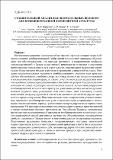| dc.contributor.author | Барсуков, Владимир Георгиевич | |
| dc.contributor.author | Волик, Алла Ричардовна | |
| dc.contributor.author | Сазон, Светлана Александровна | |
| dc.coverage.spatial | Брест | ru_RU |
| dc.date.accessioned | 2023-03-22T12:22:17Z | |
| dc.date.available | 2023-03-22T12:22:17Z | |
| dc.date.issued | 2022 | |
| dc.identifier.citation | Барсуков, В. Г. Сравнительный анализ высокомодульных волокон для комбинированной композитной арматуры / В. Г. Барсуков, А. Р. Волик, С. А. Сазон // Перспективные направления инновационного развития строительства и подготовки инженерных кадров : сборник научных статей XXII Международного научно-методического семинара, Брест, 29–30 сентября 2022 г. / Министерство образования Республики Беларусь, Брестский государственный технический университет; редкол.: С. М. Семенюк [и др.]. – Брест : БрГТУ, 2022. – С. 5–18 : ил. – Библиогр.: с. 15–18 (23 назв.). | ru_RU |
| dc.identifier.uri | https://rep.bstu.by/handle/data/32936 | |
| dc.description | Barsukov Vladimir Georgievich, Volik Alla Richardovna, Sazon Svetlana Alexandrovna. Comporative analysis of high-modulus fibers for combined composite reinforcements | ru_RU |
| dc.description.abstract | Интенсивное развитие исследований во многих научных центрах мира в области создания комбинированной (гибридной) композитной арматуры обусловлено тем обстоятельством, что высокая прочность и коррозионная стойкость стеклопластиковой и базальтопластиковой арматуры не позволяет в настоящее время массово использовать ее в строительных конструкциях вследствие значительно более низкого модуля упругости в сравнении с арматурой из стали. Введение высокомодульных волокон в комбинированную композитную арматуру требует обоснованного выбора конкретного вида волокон не только по ценовым и технологическим параметрам, но также с учетом возможных механизмов многостадийного процесса разрушения при испытаниях на разрыв. Предложена комплексная методика структурно-механического анализа механизмов разрушения комбинированной композитной арматуры, учитывающая вид высокомодульных волокон (хрупкие типа углеродных или пластичные типа стальных), степень наполнения, модули упругости и показатели прочностных свойств (предел прочности и предел текучести). Показана возможность и определены условия снижения прочности комбинированных углестеклопластиков в сравнении с исходными стеклопластикам, наряду с увеличением модуля упругости на первом этапе нагружения. На примере углеродных волокон ведущих мировых производителей, а также углеродных волокон производства Республики Беларусь произведена расчетная оценка теоретической прочности комбинированного композита с учетом характерных стадий диаграммы растяжения, обусловленных несовпадением свойств стеклянных (базальтовых) и высокомодульных (углеродные) волокон. Полученные результаты позволяют модернизировать методику прогнозной оценки прочности композитной строительной арматуры и могут быть использованы инженерно-техническими работниками предприятий-изготовителей и потребителей такой арматуры, а также в учебном процессе при подготовке инженерных кадров строительного профиля. | ru_RU |
| dc.language.iso | ru | ru_RU |
| dc.publisher | БрГТУ | ru_RU |
| dc.subject | комбинированная композитная арматура | ru_RU |
| dc.subject | combined composite reinforcement | ru_RU |
| dc.subject | прочность | ru_RU |
| dc.subject | strength | ru_RU |
| dc.subject | механизмы разрушения | ru_RU |
| dc.subject | destruction mechanisms | ru_RU |
| dc.subject | многостадийность разрыва | ru_RU |
| dc.subject | multi-stage fracture | ru_RU |
| dc.subject | растяжение | ru_RU |
| dc.subject | tension | ru_RU |
| dc.subject | армирующие волокна | ru_RU |
| dc.subject | reinforcing fibers | ru_RU |
| dc.title | Сравнительный анализ высокомодульных волокон для комбинированной композитной арматуры | ru_RU |
| dc.type | Научный доклад (Working Paper) | ru_RU |
| dc.identifier.udc | 691.175.3 | ru_RU |
| dc.abstract.alternative | The intensive development of research in many scientific centers of the world in the field of creating combined (hybrid) composite reinforcement is due to the fact that the high strength and corrosion resistance of fiberglass and basalt- plastic reinforcement does not currently allow it to be widely used in building structures due to a significantly lower modulus of elasticity in comparison with steel one. The introduction of high- modulus fiber into combined composite reinforcement requires a reasonable choice of a specific type of fiber, not only in terms of price and technological parameters, but also taking into account the possible mechanisms of the multistage fracture process during tensile test. A comprehensive method for the structural – mechanical analysis of the mechanisms of combined composite reinforcement destruction is proposed, taking into account the type of high-modulus fibers (brittle carbon type or ductile), degree of filling, elastic moduli and indicators of strength properties (tensile strength and yield stresses). The possibility is shown and the condition for reducing the strength of combined carbon fiber glass plastics in comparison with the original glassreinforced plastics, along with an increase in the elastic modulus at the first stage of loading, are determined. On the example of carbon fiber from the world`s leading man-ufacturers, as well as carbon fiber produced by the Republic of Belarus, a calculated estimate of the theoretical strength of the combined composite was made, taking into account the characteristic stage of the tension diagram, due to the mismatch between the properties of glass (basalt) and high–modulus (carbon) fiber. The results obtained make it possible to modernize the method of predictive assessment of the composite building reinforcement and can be used by engineering and technical workers of manufacturers and consumers of such reinforcement, as well as in the educational process in the training of engineering personnel of the construction profile. | ru_RU |
